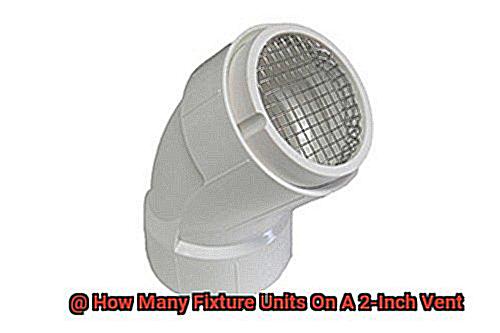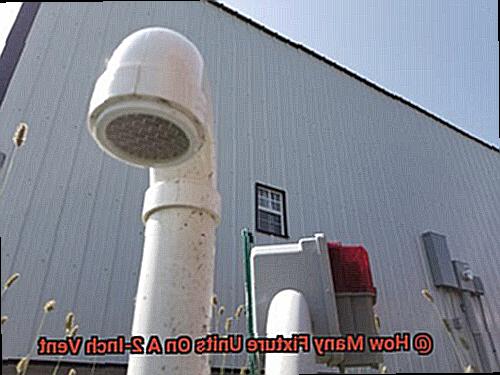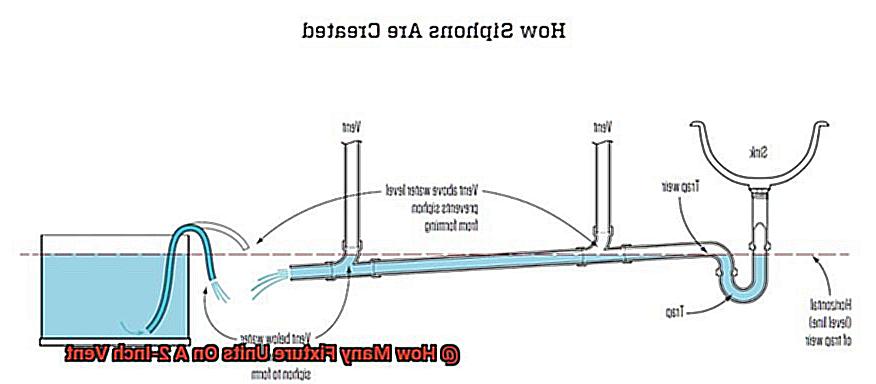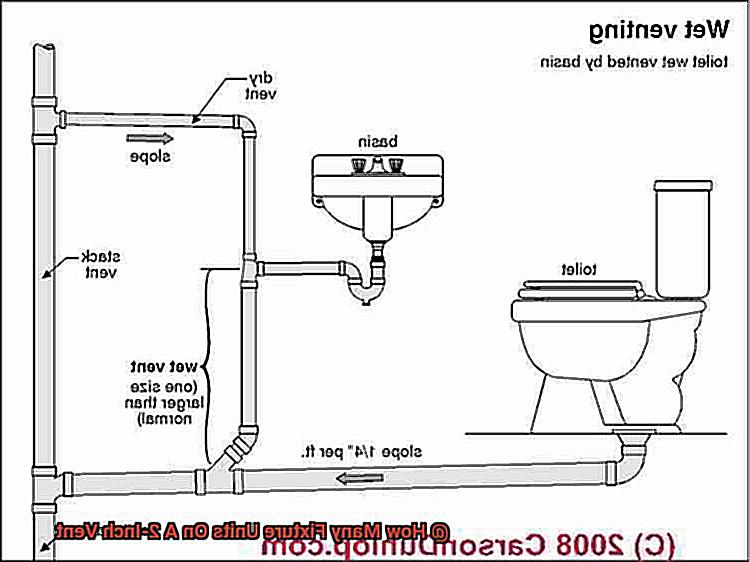Are you planning to install a 2-inch vent in your building or wondering how many plumbing fixtures it can handle? Don’t worry; you’re not alone. As a plumbing enthusiast, I have fielded countless questions about this topic, and I’ve seen firsthand the costly mistakes that arise from underestimating the importance of proper vent sizing.
Here’s the deal – a 2-inch vent has a maximum capacity measured in fixture units, which refers to the amount of water a fixture uses during peak demand. This means that if you have more fixtures, your vent system will need to accommodate more fixture units.
So, what’s the recommended number of fixture units for a 2-inch vent? According to most plumbing codes, a 2-inch vent pipe can support up to 24 fixture units. However, before you go ahead and install all 24 fixtures, there are other critical factors to consider.
The efficiency of your vent system depends on various elements such as the layout, pipe length, and number of corners or bends in the pipe system. These factors play an essential role in ensuring that your 2-inch vent system can adequately support your plumbing fixtures.
In this post, we’ll delve deeper into understanding fixture units and how they impact your plumbing system’s efficiency. We’ll also provide practical tips on how to ensure that your 2-inch vent system works seamlessly with all your plumbing fixtures.
Contents
What Are Fixture Units?
If so, it’s essential to know what fixture units are. These standardized measurements are used in plumbing to determine the expected flow rate and drainage requirements for various types of fixtures, such as toilets, sinks, and showers. Fixture units are a way to quantify the demand that each fixture places on a plumbing system.
Each plumbing fixture has a specific fixture unit rating based on its size and type. For example, a toilet typically has a fixture unit rating of 3, while a sink has a rating of The total fixture unit value for a particular building or area is determined by adding up the fixture unit values for each individual fixture.
Now, let’s talk about how fixture units relate to vents in plumbing systems. Vents play a crucial role in ensuring the proper functioning of your plumbing system by preventing the buildup of sewer gases and maintaining proper water pressure. So, how many fixture units can a 2-inch vent handle?
Although a 2-inch vent can typically handle up to 24 fixture units, several factors need to be considered when determining its actual capacity. These factors include the length of the vent, the number of bends in the vent, and the size and type of plumbing fixtures being used.
It’s important to note that when calculating the number of fixture units that a vent can handle, you should also consider the size of the drainpipe. The drainpipe should be at least one size larger than the vent to prevent any clogs or backups from occurring.
Remember that fixture unit values can vary depending on the specific fixture and its intended use. For example, a commercial-grade sink might have a higher fixture unit value than a residential sink due to its larger basin and increased water flow.
How Many Fixture Units Can A 2-Inch Vent Handle?
According to the International Plumbing Code (IPC), a 2-inch vent can handle up to 24 fixture units. This means that bathroom fixtures such as sinks, toilets, and showers typically connected to a 2-inch vent can safely discharge up to 24 fixture units without causing any issues.
However, it’s important to remember that this number could vary depending on your specific plumbing system. If your plumbing system has more fixtures connected to a single vent, the capacity of the vent to handle fixture units may decrease. The more fixtures connected to a single vent, the more water flow there will be, leaving less capacity for the vent.
To ensure you don’t run into any issues with your plumbing system, it’s always best to consult a professional plumber. They’ll assess your plumbing system and determine the maximum number of fixture units your vent can handle without causing any problems.
But that’s not all. Proper installation and ensuring that the number of fixtures connected to your vent is within its capacity limits are not the only things you need to worry about. You also need to ensure that vents are installed at the correct angle and slope for optimal drainage and ventilation. Vents that are not installed correctly could become clogged with debris or water, leading to slow drainage or even backflow.
Understanding fixture units is crucial when it comes to determining the size of pipes and vents required for optimal plumbing performance. A 2-inch vent can handle up to 24 fixture units according to IPC standards, but remember that this may vary depending on your specific plumbing system.
Factors That Affect The Capacity Of A 2-Inch Vent
Here, I will share with you the factors that affect the capacity of a 2-inch vent and how to avoid clogs and other issues.
The distance between the fixture and the vent stack is the first factor. The longer the distance, the more resistance there is in the pipe, which reduces airflow and may cause clogs. If the distance is too long, an additional vent may be necessary to maintain proper airflow.
The number of fixtures connected to a vent stack is another crucial factor. The more fixtures there are, the more air is needed to maintain proper drainage. For instance, a bathroom with multiple fixtures like a shower, sink, and toilet requires more air than one with only one fixture.
The type of fixture also affects the capacity of a 2-inch vent. Different fixtures produce different amounts of wastewater and require varying amounts of air to maintain proper drainage. For example, a toilet produces more wastewater than a sink or shower and requires more air to maintain proper drainage.
The slope of the pipe also affects its capacity. If the pipe has too much slope, it may not allow enough air to pass through, leading to clogs. Conversely, if it doesn’t have enough slope, wastewater may not flow correctly and cause blockages.
Lastly, obstructions in the pipe such as debris or mineral buildup can reduce the capacity of a 2-inch vent and cause clogs. Regular maintenance and cleaning can help prevent these issues from occurring.

The Importance Of Properly Sizing Your Drainpipe

Proper sizing of your drainpipe is crucial for the efficient functioning of your plumbing system.
When determining the size of your drainpipe, one of the most critical factors to consider is the number of fixture units that will be connected to it. Fixture units refer to the number of drainage points that will be connected to a particular drainpipe.
Keep in mind that different fixtures have varying fixture unit values. For instance, a toilet has a fixture unit value of 3, while a bathroom sink has a value of Therefore, it is essential to consider the types and number of fixtures that will be connected to the drainpipe when determining its size.
If your drainpipe is too small for the number of fixtures connected to it, you may experience slow draining and frequent clogs. On the other hand, if your drainpipe is oversized, water may move too slowly, leading to clogs and backups. This can cause significant damage to both your plumbing system and property.
To prevent such issues, it’s crucial to properly size your drainpipe. By doing so, you can prevent clogs and backups that can lead to costly repairs in the future. A 2-inch vent can handle up to 24 fixture units, but it’s always best to consult with a professional plumber for proper sizing recommendations.
Tips For Ensuring Your Plumbing System Is Properly Designed And Installed
Designing and installing a plumbing system is not something to take lightly. It’s essential to ensure that it’s done correctly to avoid any future issues with your bathroom fixtures.
Here are some ways to consider when ensuring your plumbing system is properly designed and installed.
Work with a Licensed Plumber
When it comes to plumbing, experience matters. It’s crucial to work with a licensed and experienced plumber who has a thorough understanding of local building codes and regulations. They will ensure that your plumbing system is designed and installed correctly, preventing potential problems down the road.
Fixture Size, Type, and Distance
Choosing the right bathroom fixtures is vital to the efficiency of your plumbing system. Consider the size and type of each fixture, as well as the distance between each fixture and the main waste stack. Taking these factors into account will help ensure proper drainage and prevent potential issues.
Proper Venting
Proper venting is critical to prevent backflow and maintain water pressure. It’s important to consult with a licensed plumber to ensure that your venting is designed correctly. They can calculate the number of fixture units on a 2-inch vent, taking into account factors such as the type and size of each fixture in your home.
Regular Maintenance
Regular maintenance is key to preventing clogs and other issues from occurring in your plumbing system. Schedule annual inspections with a licensed plumber to catch any potential problems before they become major issues.
Don’t Overlook the Details
Small details can have a significant impact on the longevity of your plumbing system. Sealing pipes and ensuring they are adequately supported can prevent leaks and other issues from arising.

Designing and installing a plumbing system requires careful consideration of several factors, including working with a licensed plumber, choosing the right fixtures, proper venting, regular maintenance, and paying attention to small details.
By following these tips, you can ensure that your plumbing system is properly designed and installed, reducing the likelihood of future bathroom fixture problems.
QD0wsG_V9H8″ >
Conclusion
In summary, a 2-inch vent’s capacity to handle fixture units is a critical factor in designing an efficient plumbing system. While plumbing codes suggest that a 2-inch vent can support up to 24 fixture units, it’s crucial to consider other factors such as the system’s layout, pipe length, and bends.
Fixture units are standardized measurements used in plumbing to determine flow rates and drainage requirements for different fixtures. The number of fixture units a vent can handle depends on several factors such as the distance between fixtures, type of fixture, slope of the pipe, and obstructions.
Optimal plumbing performance also depends on proper drainpipe sizing. If your drainpipe is too small or oversized for the number of fixtures connected to it, you may experience slow draining or frequent clogs.
To ensure your plumbing system meets all your needs while avoiding costly repairs down the line, work with a licensed plumber who understands local building codes and regulations. Properly choosing bathroom fixtures, ensuring proper venting and regular maintenance are essential. Pay attention to small details such as sealing pipes.






